“We believe you can go to 10 gigawatts of renewable resources” across the Navajo Nation, as coal plant retirements in the area open up transmission capacity, said Navajo Power CEO Brett Isaac, in a pv magazine interview. The Navajo Nation extends across parts of Arizona, Utah and New Mexico.
Navajo Power is preparing a bid to build 200 MW of solar power, after the Arizona utility Salt River Project issued a bid request specifying solar on Navajo Nation lands. The solar project selected by the utility will help make up for generation capacity lost last November when the coal-fired Navajo Generating Station closed; the utility will pay the Navajo Nation for the use of its transmission lines.
The 10 GW renewables potential, Isaac said, will emerge as three other coal plants in the area retire, largely due to the “price competitiveness” of solar, wind and storage projects. The three plants are the San Juan Generating Station, which is scheduled to close in 2022, the Cholla Power Plant, “just off the Navajo Nation along I-40,” where one of the three units will retire this year, and the Four Corners power plant on Navajo Nation lands. The Four Corners plant is scheduled to close in 2031, but Isaac said “the economics will probably force” an earlier closure.
Solar capacity could exceed the capacity of the transmission lines fanning out from these coal plants, if storage were added or if a high inverter loading ratio were used.
Solar-friendly approval process
Navajo Power’s proposed 200 MW project would be sited on lands currently used for grazing in the Coalmine Canyon Chapter—chapters are the community level of government within the Navajo Nation—and would need transmission access across the Cameron Chapter to interconnect to the grid, according to reporting by Rima Krisst for the Navajo Times. The company’s project has obtained “overwhelming” approval from both chapters to proceed to the next stage of development, Isaac said. The company is also pursuing the protocols to obtain Navajo Nation approval, he said.
Looking to the future, the Navajo Nation “can play a very strong part in the Southwest” if it becomes “a friendly environment for the development of these resources, because we have the land base and the transmission,” said Isaac, a member of the Navajo Nation.
“But all those elements need to be carefully thought about and prioritized by the government’s own regulatory side, in order to see this through.” Projects must be efficient in order to sell power to markets such as Los Angeles, Phoenix, and Las Vegas, he said, as those markets are “heavily competitive.”
Navajo Equitable Economy, a project of three Navajo organizations, agrees and brings an equity focus, calling for the Navajo Nation government “to develop a clear, efficient process for developers to follow to be able to build projects on Navajo land or Navajo-owned land that assures benefits to local communities.”
Isaac acknowledged that other landowners in the area will likely also receive offers to lease their land for solar developments. He cited the example of border towns just outside the Navajo Nation that have captured much of the retail and entertainment spending of Navajo Nation residents.
Isaac found support for improving the regulatory approval processes for solar, wind, and storage projects in the Navajo Sunrise Proclamation issued by Navajo Nation President Jonathan Nez and Vice President Myron Lizer in April 2019. The proclamation says the Nez-Lizer Administration “supports amending the Navajo Energy Policy of 2013 to prioritize renewable energy, while creating an energy office to oversee energy projects and development.” A bill was introduced in the Navajo Nation legislature last spring that would have amended the energy policy to favor renewables, but the bill was first tabled, and then withdrawn, said Nicole Horseherder, executive director of Tó Nizhóní Ání.
Transmission shifting from coal to solar
Coal plants across the Southwest generally “have long transmission lines that connect them to load centers,” and are typically located in ranchland areas suitable for solar development, said Joseph Daniel, a senior energy analyst who conducts studies on coal generation for the Union of Concerned Scientists.
In other parts of the U.S., coal plants may have been built in commercial or residential areas not suited to utility-scale solar, Daniel suggested. Yet in the Midwest and Southeast, large solar farms in states such as North Carolina are in part using the same transmission lines that were once used for coal, he said.
Still, “there is a need for additional new transmission lines to connect the best solar resources to the most densely populated areas,” he said, adding that “there needs to be more investment in national transmission lines.”






